Analysis of IT Solutions, Globalisation, and Digital Infrastructure
VerifiedAdded on 2023/06/10
|10
|3152
|96
Report
AI Summary
This report delves into the realm of IT systems, exploring their role in data management, decision-making, and communication. It begins by defining IT systems and introduces various solutions such as Canvas and MS Office, analyzing their design and development theories. The report then explains key IT systems including DSS, ESS, TPS, MIS, and KSM, providing real-world examples for each. Furthermore, it examines the concept of globalization and the significant impact of IT on its expansion. A detailed discussion on digital infrastructure follows, including its definition, advantages, and disadvantages. The report concludes by addressing the risks associated with information systems outsourcing and emphasizing the critical role of IT infrastructure in digital transformation, offering a comprehensive overview of the interplay between IT and these crucial concepts.
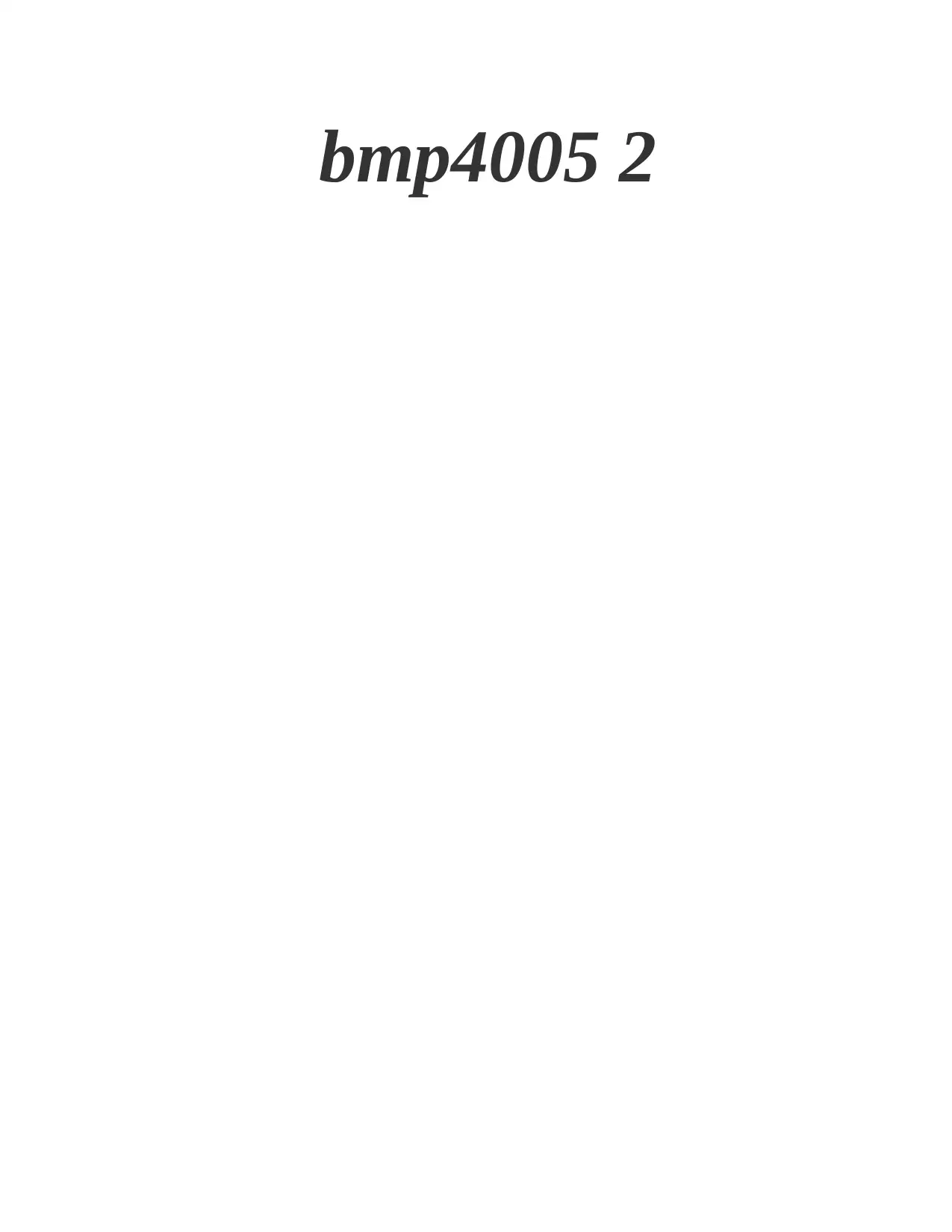
bmp4005 2
Paraphrase This Document
Need a fresh take? Get an instant paraphrase of this document with our AI Paraphraser
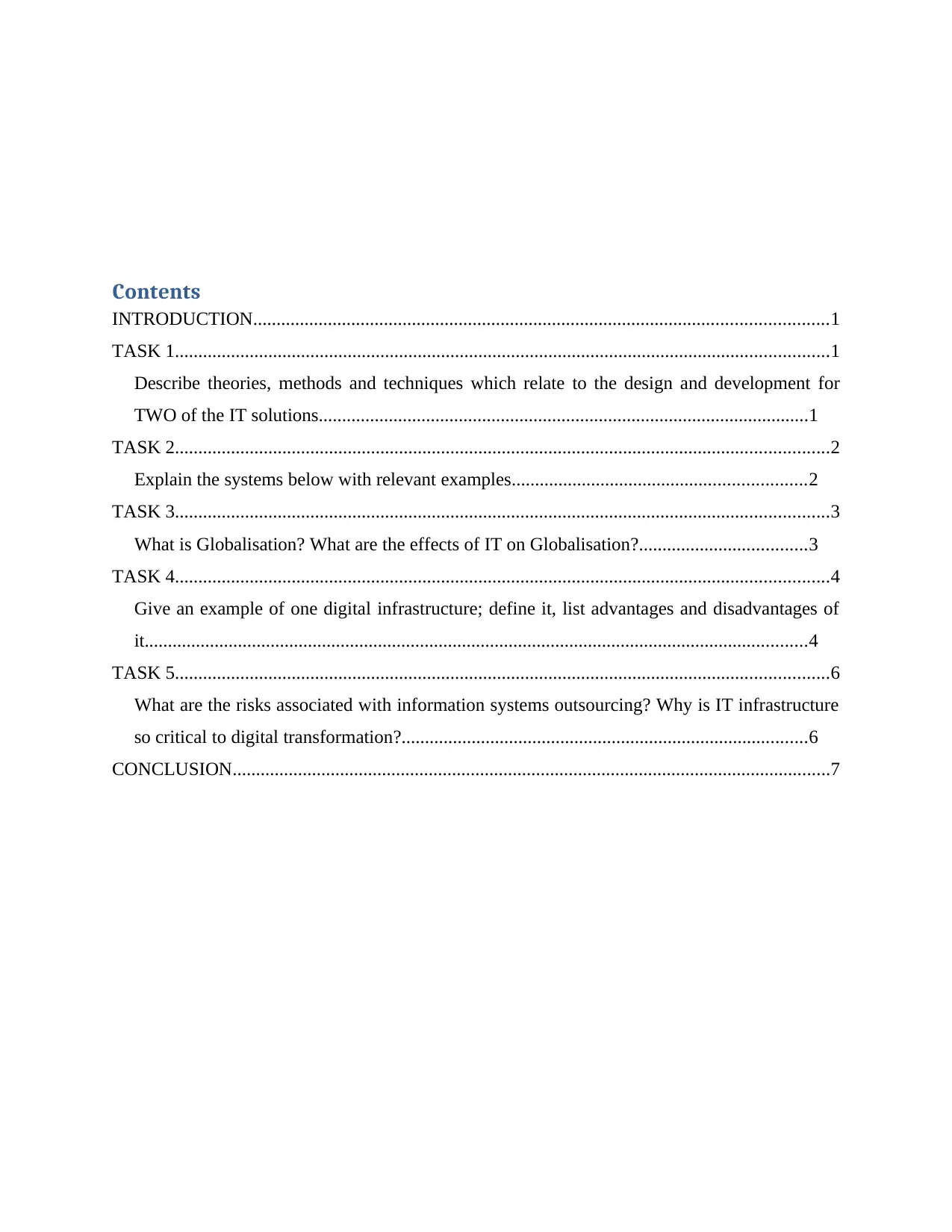
Contents
INTRODUCTION...........................................................................................................................1
TASK 1............................................................................................................................................1
Describe theories, methods and techniques which relate to the design and development for
TWO of the IT solutions.........................................................................................................1
TASK 2............................................................................................................................................2
Explain the systems below with relevant examples...............................................................2
TASK 3............................................................................................................................................3
What is Globalisation? What are the effects of IT on Globalisation?....................................3
TASK 4............................................................................................................................................4
Give an example of one digital infrastructure; define it, list advantages and disadvantages of
it..............................................................................................................................................4
TASK 5............................................................................................................................................6
What are the risks associated with information systems outsourcing? Why is IT infrastructure
so critical to digital transformation?.......................................................................................6
CONCLUSION................................................................................................................................7
INTRODUCTION...........................................................................................................................1
TASK 1............................................................................................................................................1
Describe theories, methods and techniques which relate to the design and development for
TWO of the IT solutions.........................................................................................................1
TASK 2............................................................................................................................................2
Explain the systems below with relevant examples...............................................................2
TASK 3............................................................................................................................................3
What is Globalisation? What are the effects of IT on Globalisation?....................................3
TASK 4............................................................................................................................................4
Give an example of one digital infrastructure; define it, list advantages and disadvantages of
it..............................................................................................................................................4
TASK 5............................................................................................................................................6
What are the risks associated with information systems outsourcing? Why is IT infrastructure
so critical to digital transformation?.......................................................................................6
CONCLUSION................................................................................................................................7
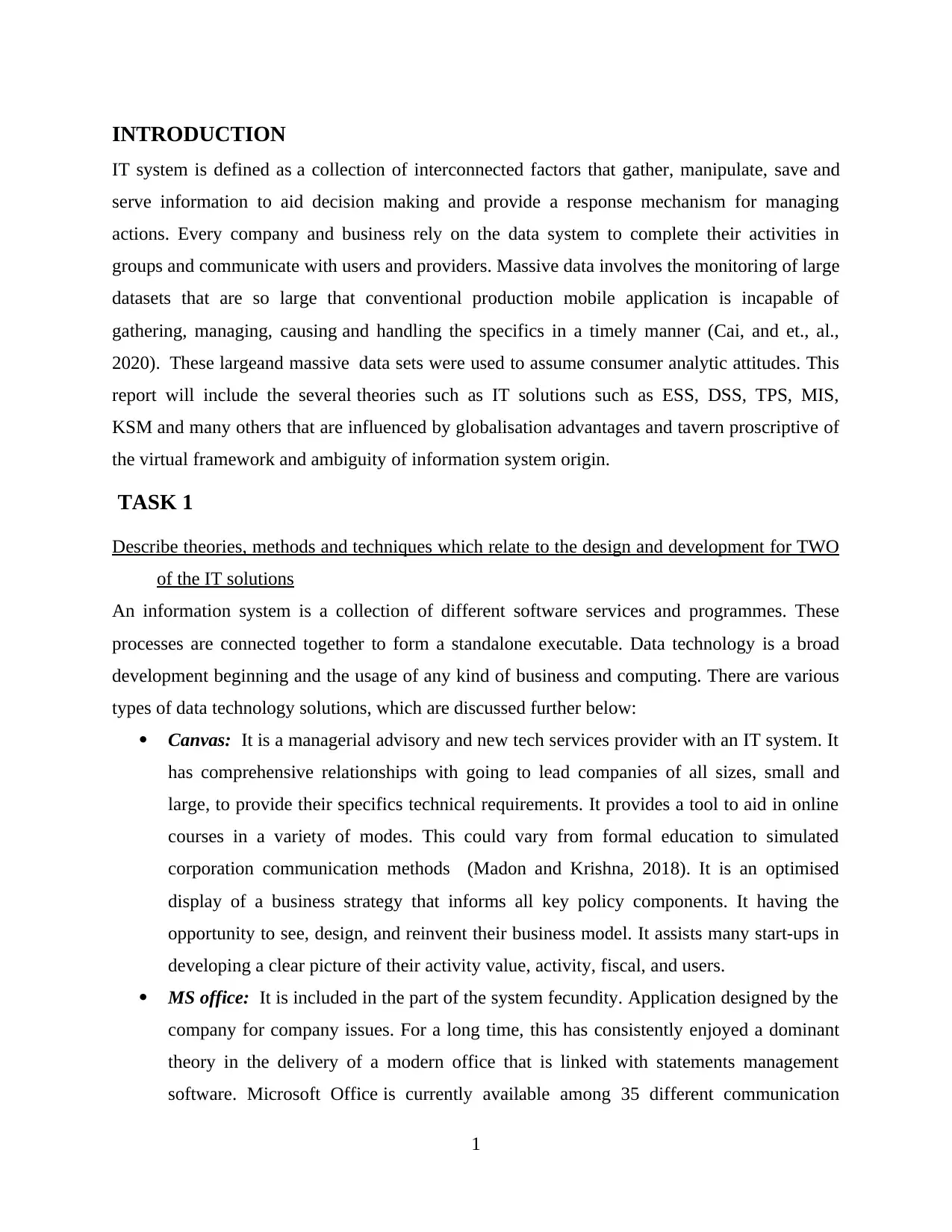
INTRODUCTION
IT system is defined as a collection of interconnected factors that gather, manipulate, save and
serve information to aid decision making and provide a response mechanism for managing
actions. Every company and business rely on the data system to complete their activities in
groups and communicate with users and providers. Massive data involves the monitoring of large
datasets that are so large that conventional production mobile application is incapable of
gathering, managing, causing and handling the specifics in a timely manner (Cai, and et., al.,
2020). These largeand massive data sets were used to assume consumer analytic attitudes. This
report will include the several theories such as IT solutions such as ESS, DSS, TPS, MIS,
KSM and many others that are influenced by globalisation advantages and tavern proscriptive of
the virtual framework and ambiguity of information system origin.
TASK 1
Describe theories, methods and techniques which relate to the design and development for TWO
of the IT solutions
An information system is a collection of different software services and programmes. These
processes are connected together to form a standalone executable. Data technology is a broad
development beginning and the usage of any kind of business and computing. There are various
types of data technology solutions, which are discussed further below:
Canvas: It is a managerial advisory and new tech services provider with an IT system. It
has comprehensive relationships with going to lead companies of all sizes, small and
large, to provide their specifics technical requirements. It provides a tool to aid in online
courses in a variety of modes. This could vary from formal education to simulated
corporation communication methods (Madon and Krishna, 2018). It is an optimised
display of a business strategy that informs all key policy components. It having the
opportunity to see, design, and reinvent their business model. It assists many start-ups in
developing a clear picture of their activity value, activity, fiscal, and users.
MS office: It is included in the part of the system fecundity. Application designed by the
company for company issues. For a long time, this has consistently enjoyed a dominant
theory in the delivery of a modern office that is linked with statements management
software. Microsoft Office is currently available among 35 different communication
1
IT system is defined as a collection of interconnected factors that gather, manipulate, save and
serve information to aid decision making and provide a response mechanism for managing
actions. Every company and business rely on the data system to complete their activities in
groups and communicate with users and providers. Massive data involves the monitoring of large
datasets that are so large that conventional production mobile application is incapable of
gathering, managing, causing and handling the specifics in a timely manner (Cai, and et., al.,
2020). These largeand massive data sets were used to assume consumer analytic attitudes. This
report will include the several theories such as IT solutions such as ESS, DSS, TPS, MIS,
KSM and many others that are influenced by globalisation advantages and tavern proscriptive of
the virtual framework and ambiguity of information system origin.
TASK 1
Describe theories, methods and techniques which relate to the design and development for TWO
of the IT solutions
An information system is a collection of different software services and programmes. These
processes are connected together to form a standalone executable. Data technology is a broad
development beginning and the usage of any kind of business and computing. There are various
types of data technology solutions, which are discussed further below:
Canvas: It is a managerial advisory and new tech services provider with an IT system. It
has comprehensive relationships with going to lead companies of all sizes, small and
large, to provide their specifics technical requirements. It provides a tool to aid in online
courses in a variety of modes. This could vary from formal education to simulated
corporation communication methods (Madon and Krishna, 2018). It is an optimised
display of a business strategy that informs all key policy components. It having the
opportunity to see, design, and reinvent their business model. It assists many start-ups in
developing a clear picture of their activity value, activity, fiscal, and users.
MS office: It is included in the part of the system fecundity. Application designed by the
company for company issues. For a long time, this has consistently enjoyed a dominant
theory in the delivery of a modern office that is linked with statements management
software. Microsoft Office is currently available among 35 different communication
1
⊘ This is a preview!⊘
Do you want full access?
Subscribe today to unlock all pages.

Trusted by 1+ million students worldwide
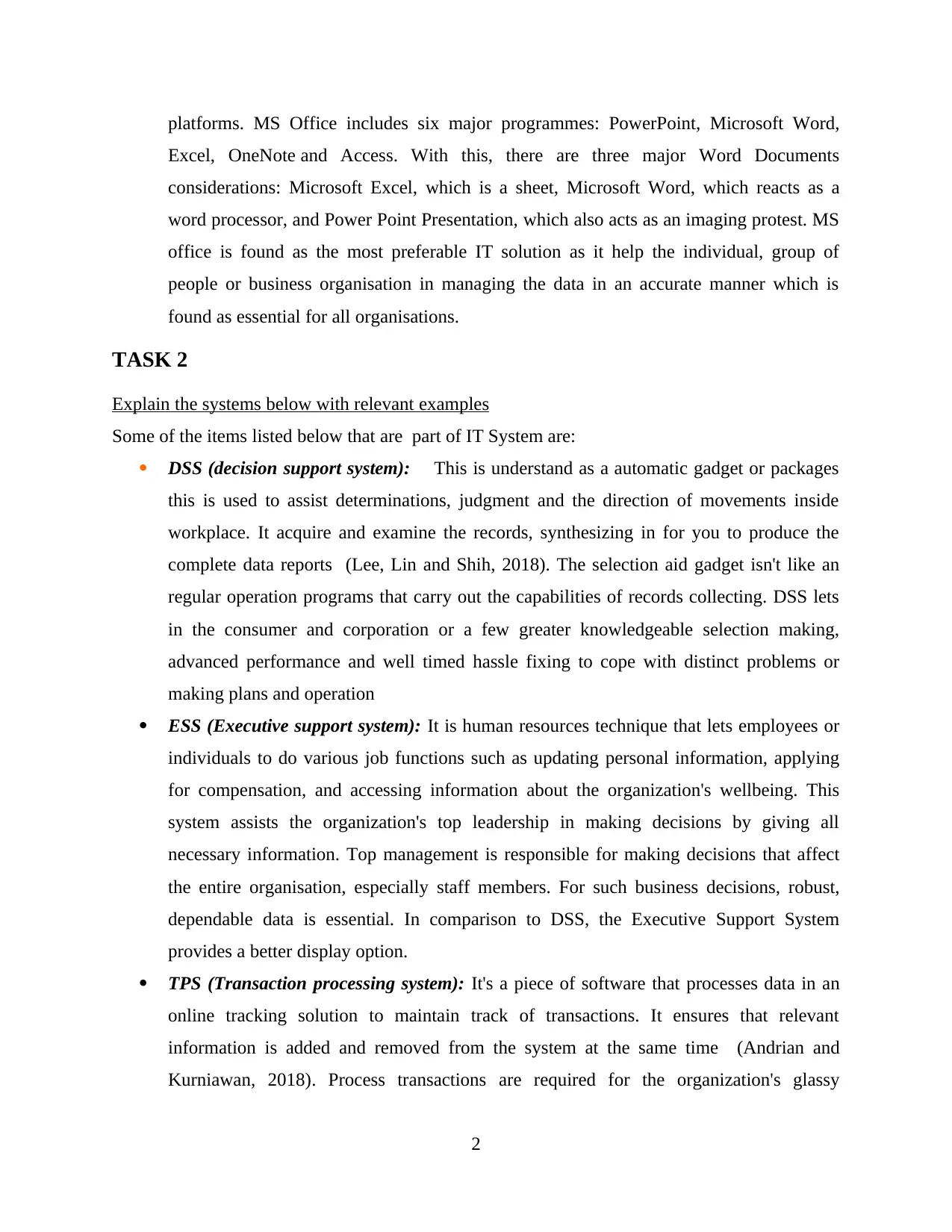
platforms. MS Office includes six major programmes: PowerPoint, Microsoft Word,
Excel, OneNote and Access. With this, there are three major Word Documents
considerations: Microsoft Excel, which is a sheet, Microsoft Word, which reacts as a
word processor, and Power Point Presentation, which also acts as an imaging protest. MS
office is found as the most preferable IT solution as it help the individual, group of
people or business organisation in managing the data in an accurate manner which is
found as essential for all organisations.
TASK 2
Explain the systems below with relevant examples
Some of the items listed below that are part of IT System are:
DSS (decision support system): This is understand as a automatic gadget or packages
this is used to assist determinations, judgment and the direction of movements inside
workplace. It acquire and examine the records, synthesizing in for you to produce the
complete data reports (Lee, Lin and Shih, 2018). The selection aid gadget isn't like an
regular operation programs that carry out the capabilities of records collecting. DSS lets
in the consumer and corporation or a few greater knowledgeable selection making,
advanced performance and well timed hassle fixing to cope with distinct problems or
making plans and operation
ESS (Executive support system): It is human resources technique that lets employees or
individuals to do various job functions such as updating personal information, applying
for compensation, and accessing information about the organization's wellbeing. This
system assists the organization's top leadership in making decisions by giving all
necessary information. Top management is responsible for making decisions that affect
the entire organisation, especially staff members. For such business decisions, robust,
dependable data is essential. In comparison to DSS, the Executive Support System
provides a better display option.
TPS (Transaction processing system): It's a piece of software that processes data in an
online tracking solution to maintain track of transactions. It ensures that relevant
information is added and removed from the system at the same time (Andrian and
Kurniawan, 2018). Process transactions are required for the organization's glassy
2
Excel, OneNote and Access. With this, there are three major Word Documents
considerations: Microsoft Excel, which is a sheet, Microsoft Word, which reacts as a
word processor, and Power Point Presentation, which also acts as an imaging protest. MS
office is found as the most preferable IT solution as it help the individual, group of
people or business organisation in managing the data in an accurate manner which is
found as essential for all organisations.
TASK 2
Explain the systems below with relevant examples
Some of the items listed below that are part of IT System are:
DSS (decision support system): This is understand as a automatic gadget or packages
this is used to assist determinations, judgment and the direction of movements inside
workplace. It acquire and examine the records, synthesizing in for you to produce the
complete data reports (Lee, Lin and Shih, 2018). The selection aid gadget isn't like an
regular operation programs that carry out the capabilities of records collecting. DSS lets
in the consumer and corporation or a few greater knowledgeable selection making,
advanced performance and well timed hassle fixing to cope with distinct problems or
making plans and operation
ESS (Executive support system): It is human resources technique that lets employees or
individuals to do various job functions such as updating personal information, applying
for compensation, and accessing information about the organization's wellbeing. This
system assists the organization's top leadership in making decisions by giving all
necessary information. Top management is responsible for making decisions that affect
the entire organisation, especially staff members. For such business decisions, robust,
dependable data is essential. In comparison to DSS, the Executive Support System
provides a better display option.
TPS (Transaction processing system): It's a piece of software that processes data in an
online tracking solution to maintain track of transactions. It ensures that relevant
information is added and removed from the system at the same time (Andrian and
Kurniawan, 2018). Process transactions are required for the organization's glassy
2
Paraphrase This Document
Need a fresh take? Get an instant paraphrase of this document with our AI Paraphraser
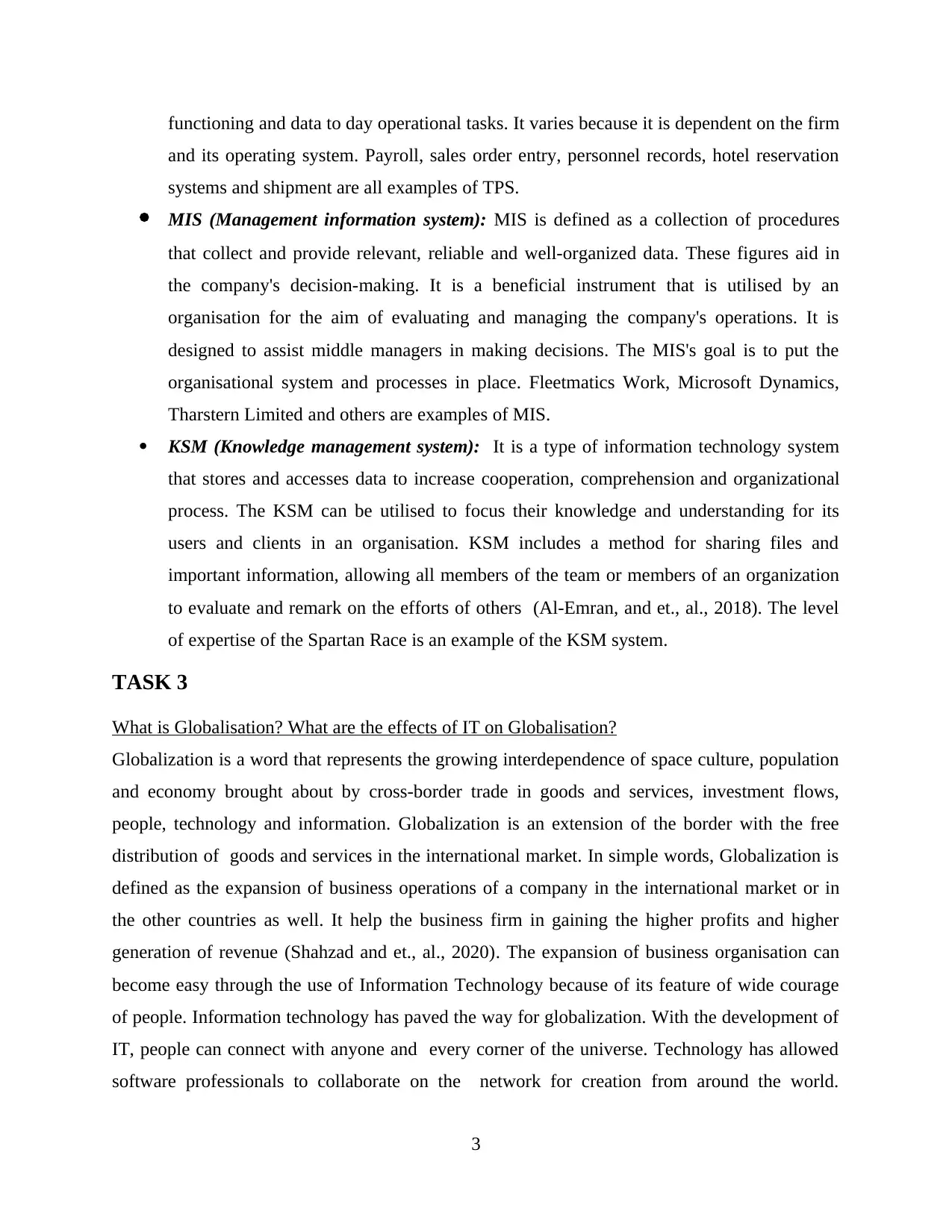
functioning and data to day operational tasks. It varies because it is dependent on the firm
and its operating system. Payroll, sales order entry, personnel records, hotel reservation
systems and shipment are all examples of TPS.
MIS (Management information system): MIS is defined as a collection of procedures
that collect and provide relevant, reliable and well-organized data. These figures aid in
the company's decision-making. It is a beneficial instrument that is utilised by an
organisation for the aim of evaluating and managing the company's operations. It is
designed to assist middle managers in making decisions. The MIS's goal is to put the
organisational system and processes in place. Fleetmatics Work, Microsoft Dynamics,
Tharstern Limited and others are examples of MIS.
KSM (Knowledge management system): It is a type of information technology system
that stores and accesses data to increase cooperation, comprehension and organizational
process. The KSM can be utilised to focus their knowledge and understanding for its
users and clients in an organisation. KSM includes a method for sharing files and
important information, allowing all members of the team or members of an organization
to evaluate and remark on the efforts of others (Al-Emran, and et., al., 2018). The level
of expertise of the Spartan Race is an example of the KSM system.
TASK 3
What is Globalisation? What are the effects of IT on Globalisation?
Globalization is a word that represents the growing interdependence of space culture, population
and economy brought about by cross-border trade in goods and services, investment flows,
people, technology and information. Globalization is an extension of the border with the free
distribution of goods and services in the international market. In simple words, Globalization is
defined as the expansion of business operations of a company in the international market or in
the other countries as well. It help the business firm in gaining the higher profits and higher
generation of revenue (Shahzad and et., al., 2020). The expansion of business organisation can
become easy through the use of Information Technology because of its feature of wide courage
of people. Information technology has paved the way for globalization. With the development of
IT, people can connect with anyone and every corner of the universe. Technology has allowed
software professionals to collaborate on the network for creation from around the world.
3
and its operating system. Payroll, sales order entry, personnel records, hotel reservation
systems and shipment are all examples of TPS.
MIS (Management information system): MIS is defined as a collection of procedures
that collect and provide relevant, reliable and well-organized data. These figures aid in
the company's decision-making. It is a beneficial instrument that is utilised by an
organisation for the aim of evaluating and managing the company's operations. It is
designed to assist middle managers in making decisions. The MIS's goal is to put the
organisational system and processes in place. Fleetmatics Work, Microsoft Dynamics,
Tharstern Limited and others are examples of MIS.
KSM (Knowledge management system): It is a type of information technology system
that stores and accesses data to increase cooperation, comprehension and organizational
process. The KSM can be utilised to focus their knowledge and understanding for its
users and clients in an organisation. KSM includes a method for sharing files and
important information, allowing all members of the team or members of an organization
to evaluate and remark on the efforts of others (Al-Emran, and et., al., 2018). The level
of expertise of the Spartan Race is an example of the KSM system.
TASK 3
What is Globalisation? What are the effects of IT on Globalisation?
Globalization is a word that represents the growing interdependence of space culture, population
and economy brought about by cross-border trade in goods and services, investment flows,
people, technology and information. Globalization is an extension of the border with the free
distribution of goods and services in the international market. In simple words, Globalization is
defined as the expansion of business operations of a company in the international market or in
the other countries as well. It help the business firm in gaining the higher profits and higher
generation of revenue (Shahzad and et., al., 2020). The expansion of business organisation can
become easy through the use of Information Technology because of its feature of wide courage
of people. Information technology has paved the way for globalization. With the development of
IT, people can connect with anyone and every corner of the universe. Technology has allowed
software professionals to collaborate on the network for creation from around the world.
3
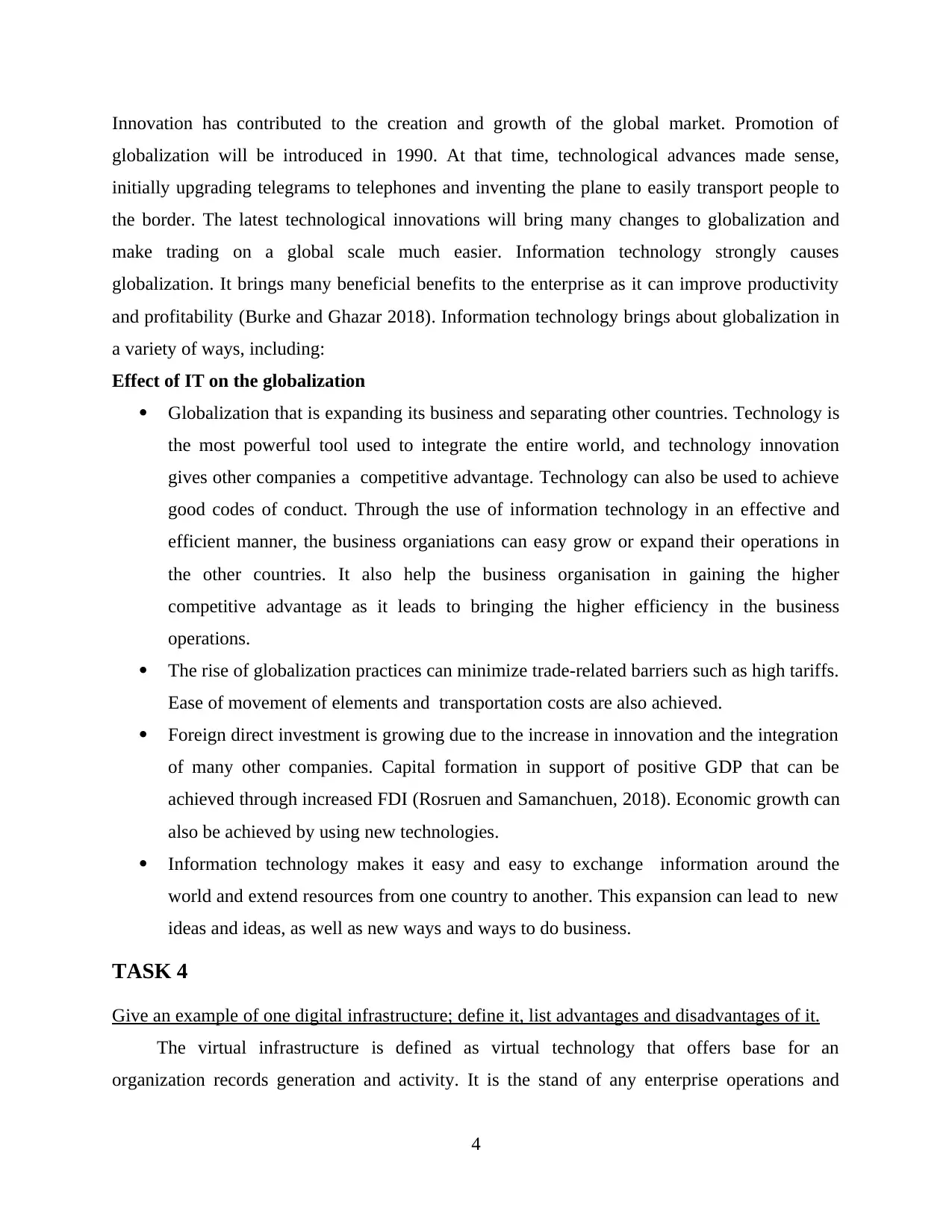
Innovation has contributed to the creation and growth of the global market. Promotion of
globalization will be introduced in 1990. At that time, technological advances made sense,
initially upgrading telegrams to telephones and inventing the plane to easily transport people to
the border. The latest technological innovations will bring many changes to globalization and
make trading on a global scale much easier. Information technology strongly causes
globalization. It brings many beneficial benefits to the enterprise as it can improve productivity
and profitability (Burke and Ghazar 2018). Information technology brings about globalization in
a variety of ways, including:
Effect of IT on the globalization
Globalization that is expanding its business and separating other countries. Technology is
the most powerful tool used to integrate the entire world, and technology innovation
gives other companies a competitive advantage. Technology can also be used to achieve
good codes of conduct. Through the use of information technology in an effective and
efficient manner, the business organiations can easy grow or expand their operations in
the other countries. It also help the business organisation in gaining the higher
competitive advantage as it leads to bringing the higher efficiency in the business
operations.
The rise of globalization practices can minimize trade-related barriers such as high tariffs.
Ease of movement of elements and transportation costs are also achieved.
Foreign direct investment is growing due to the increase in innovation and the integration
of many other companies. Capital formation in support of positive GDP that can be
achieved through increased FDI (Rosruen and Samanchuen, 2018). Economic growth can
also be achieved by using new technologies.
Information technology makes it easy and easy to exchange information around the
world and extend resources from one country to another. This expansion can lead to new
ideas and ideas, as well as new ways and ways to do business.
TASK 4
Give an example of one digital infrastructure; define it, list advantages and disadvantages of it.
The virtual infrastructure is defined as virtual technology that offers base for an
organization records generation and activity. It is the stand of any enterprise operations and
4
globalization will be introduced in 1990. At that time, technological advances made sense,
initially upgrading telegrams to telephones and inventing the plane to easily transport people to
the border. The latest technological innovations will bring many changes to globalization and
make trading on a global scale much easier. Information technology strongly causes
globalization. It brings many beneficial benefits to the enterprise as it can improve productivity
and profitability (Burke and Ghazar 2018). Information technology brings about globalization in
a variety of ways, including:
Effect of IT on the globalization
Globalization that is expanding its business and separating other countries. Technology is
the most powerful tool used to integrate the entire world, and technology innovation
gives other companies a competitive advantage. Technology can also be used to achieve
good codes of conduct. Through the use of information technology in an effective and
efficient manner, the business organiations can easy grow or expand their operations in
the other countries. It also help the business organisation in gaining the higher
competitive advantage as it leads to bringing the higher efficiency in the business
operations.
The rise of globalization practices can minimize trade-related barriers such as high tariffs.
Ease of movement of elements and transportation costs are also achieved.
Foreign direct investment is growing due to the increase in innovation and the integration
of many other companies. Capital formation in support of positive GDP that can be
achieved through increased FDI (Rosruen and Samanchuen, 2018). Economic growth can
also be achieved by using new technologies.
Information technology makes it easy and easy to exchange information around the
world and extend resources from one country to another. This expansion can lead to new
ideas and ideas, as well as new ways and ways to do business.
TASK 4
Give an example of one digital infrastructure; define it, list advantages and disadvantages of it.
The virtual infrastructure is defined as virtual technology that offers base for an
organization records generation and activity. It is the stand of any enterprise operations and
4
⊘ This is a preview!⊘
Do you want full access?
Subscribe today to unlock all pages.

Trusted by 1+ million students worldwide
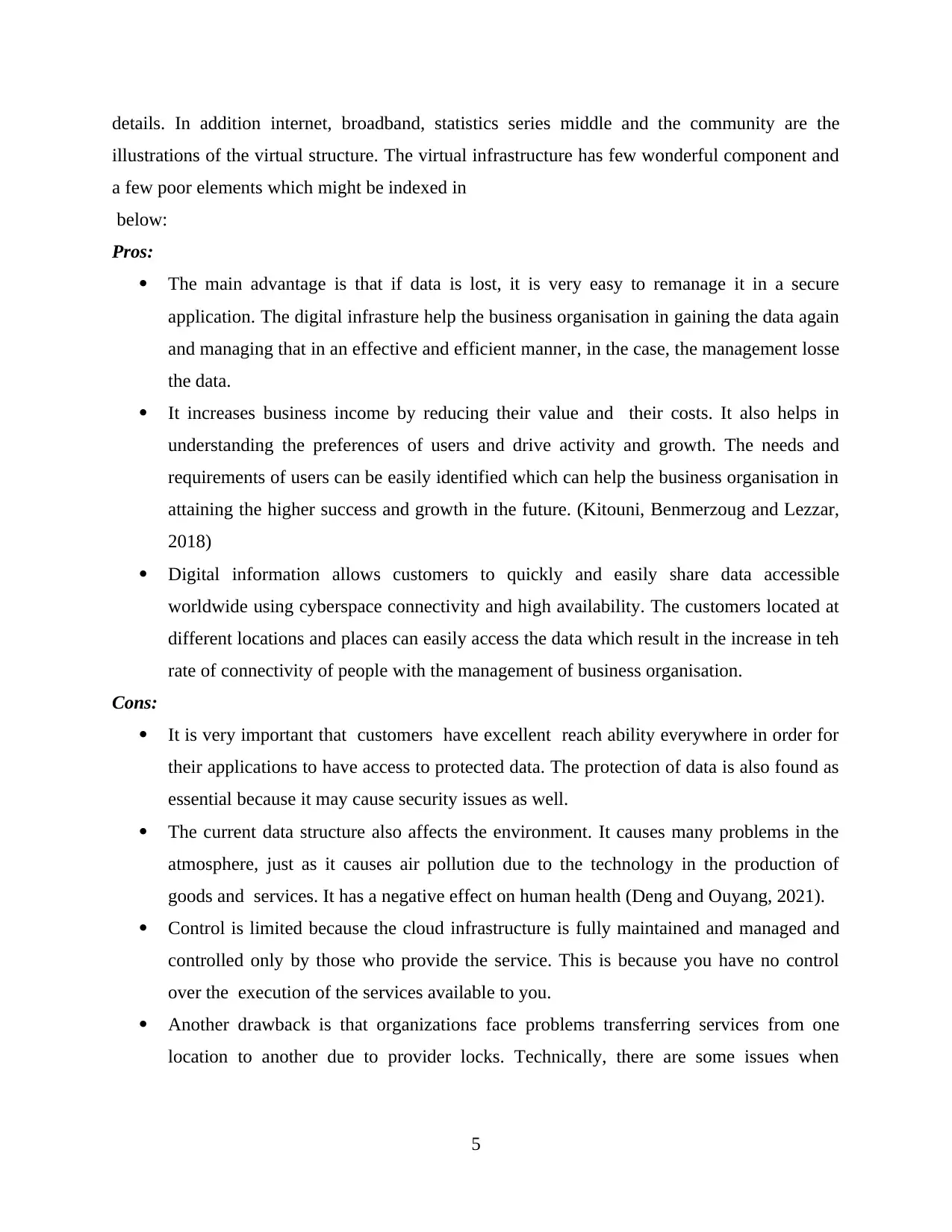
details. In addition internet, broadband, statistics series middle and the community are the
illustrations of the virtual structure. The virtual infrastructure has few wonderful component and
a few poor elements which might be indexed in
below:
Pros:
The main advantage is that if data is lost, it is very easy to remanage it in a secure
application. The digital infrasture help the business organisation in gaining the data again
and managing that in an effective and efficient manner, in the case, the management losse
the data.
It increases business income by reducing their value and their costs. It also helps in
understanding the preferences of users and drive activity and growth. The needs and
requirements of users can be easily identified which can help the business organisation in
attaining the higher success and growth in the future. (Kitouni, Benmerzoug and Lezzar,
2018)
Digital information allows customers to quickly and easily share data accessible
worldwide using cyberspace connectivity and high availability. The customers located at
different locations and places can easily access the data which result in the increase in teh
rate of connectivity of people with the management of business organisation.
Cons:
It is very important that customers have excellent reach ability everywhere in order for
their applications to have access to protected data. The protection of data is also found as
essential because it may cause security issues as well.
The current data structure also affects the environment. It causes many problems in the
atmosphere, just as it causes air pollution due to the technology in the production of
goods and services. It has a negative effect on human health (Deng and Ouyang, 2021).
Control is limited because the cloud infrastructure is fully maintained and managed and
controlled only by those who provide the service. This is because you have no control
over the execution of the services available to you.
Another drawback is that organizations face problems transferring services from one
location to another due to provider locks. Technically, there are some issues when
5
illustrations of the virtual structure. The virtual infrastructure has few wonderful component and
a few poor elements which might be indexed in
below:
Pros:
The main advantage is that if data is lost, it is very easy to remanage it in a secure
application. The digital infrasture help the business organisation in gaining the data again
and managing that in an effective and efficient manner, in the case, the management losse
the data.
It increases business income by reducing their value and their costs. It also helps in
understanding the preferences of users and drive activity and growth. The needs and
requirements of users can be easily identified which can help the business organisation in
attaining the higher success and growth in the future. (Kitouni, Benmerzoug and Lezzar,
2018)
Digital information allows customers to quickly and easily share data accessible
worldwide using cyberspace connectivity and high availability. The customers located at
different locations and places can easily access the data which result in the increase in teh
rate of connectivity of people with the management of business organisation.
Cons:
It is very important that customers have excellent reach ability everywhere in order for
their applications to have access to protected data. The protection of data is also found as
essential because it may cause security issues as well.
The current data structure also affects the environment. It causes many problems in the
atmosphere, just as it causes air pollution due to the technology in the production of
goods and services. It has a negative effect on human health (Deng and Ouyang, 2021).
Control is limited because the cloud infrastructure is fully maintained and managed and
controlled only by those who provide the service. This is because you have no control
over the execution of the services available to you.
Another drawback is that organizations face problems transferring services from one
location to another due to provider locks. Technically, there are some issues when
5
Paraphrase This Document
Need a fresh take? Get an instant paraphrase of this document with our AI Paraphraser
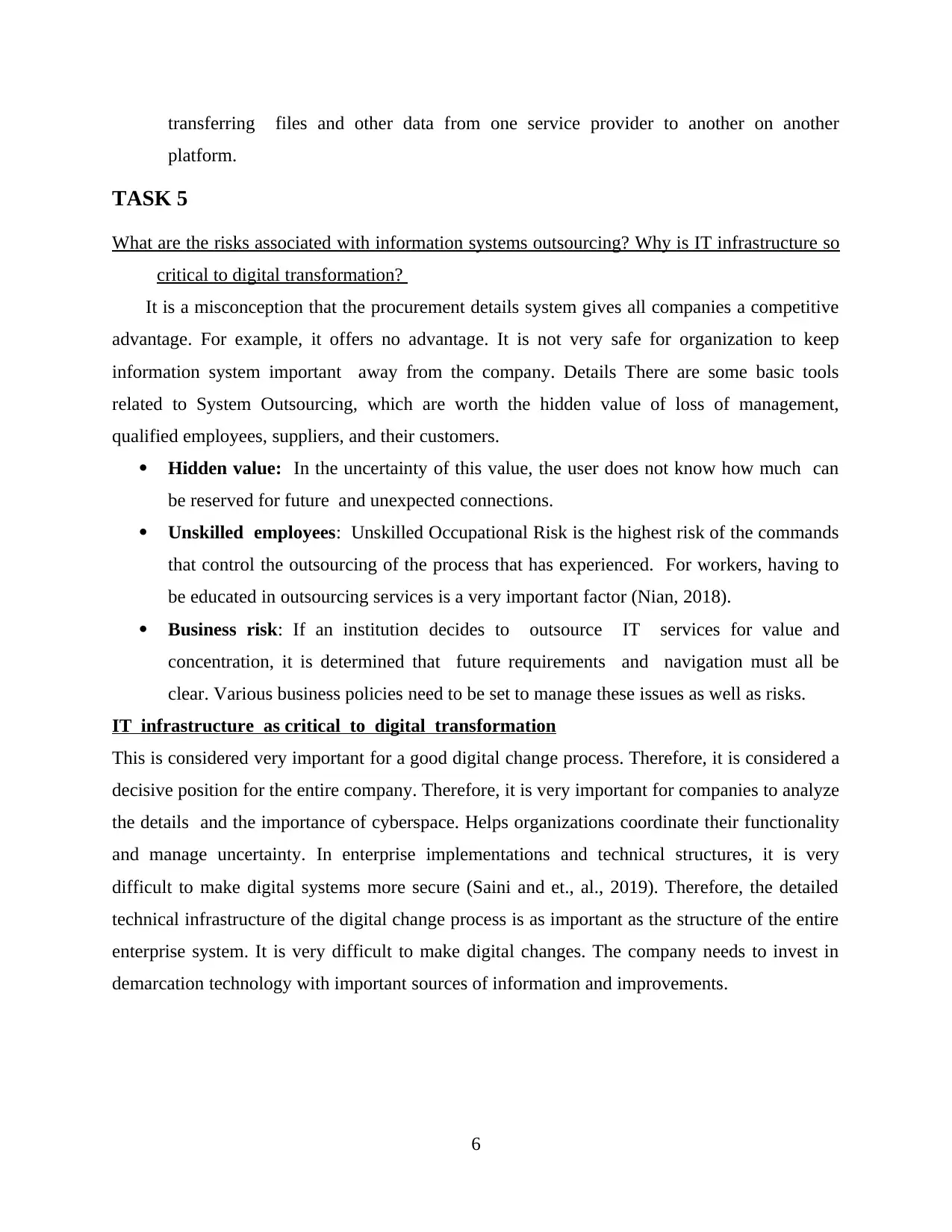
transferring files and other data from one service provider to another on another
platform.
TASK 5
What are the risks associated with information systems outsourcing? Why is IT infrastructure so
critical to digital transformation?
It is a misconception that the procurement details system gives all companies a competitive
advantage. For example, it offers no advantage. It is not very safe for organization to keep
information system important away from the company. Details There are some basic tools
related to System Outsourcing, which are worth the hidden value of loss of management,
qualified employees, suppliers, and their customers.
Hidden value: In the uncertainty of this value, the user does not know how much can
be reserved for future and unexpected connections.
Unskilled employees: Unskilled Occupational Risk is the highest risk of the commands
that control the outsourcing of the process that has experienced. For workers, having to
be educated in outsourcing services is a very important factor (Nian, 2018).
Business risk: If an institution decides to outsource IT services for value and
concentration, it is determined that future requirements and navigation must all be
clear. Various business policies need to be set to manage these issues as well as risks.
IT infrastructure as critical to digital transformation
This is considered very important for a good digital change process. Therefore, it is considered a
decisive position for the entire company. Therefore, it is very important for companies to analyze
the details and the importance of cyberspace. Helps organizations coordinate their functionality
and manage uncertainty. In enterprise implementations and technical structures, it is very
difficult to make digital systems more secure (Saini and et., al., 2019). Therefore, the detailed
technical infrastructure of the digital change process is as important as the structure of the entire
enterprise system. It is very difficult to make digital changes. The company needs to invest in
demarcation technology with important sources of information and improvements.
6
platform.
TASK 5
What are the risks associated with information systems outsourcing? Why is IT infrastructure so
critical to digital transformation?
It is a misconception that the procurement details system gives all companies a competitive
advantage. For example, it offers no advantage. It is not very safe for organization to keep
information system important away from the company. Details There are some basic tools
related to System Outsourcing, which are worth the hidden value of loss of management,
qualified employees, suppliers, and their customers.
Hidden value: In the uncertainty of this value, the user does not know how much can
be reserved for future and unexpected connections.
Unskilled employees: Unskilled Occupational Risk is the highest risk of the commands
that control the outsourcing of the process that has experienced. For workers, having to
be educated in outsourcing services is a very important factor (Nian, 2018).
Business risk: If an institution decides to outsource IT services for value and
concentration, it is determined that future requirements and navigation must all be
clear. Various business policies need to be set to manage these issues as well as risks.
IT infrastructure as critical to digital transformation
This is considered very important for a good digital change process. Therefore, it is considered a
decisive position for the entire company. Therefore, it is very important for companies to analyze
the details and the importance of cyberspace. Helps organizations coordinate their functionality
and manage uncertainty. In enterprise implementations and technical structures, it is very
difficult to make digital systems more secure (Saini and et., al., 2019). Therefore, the detailed
technical infrastructure of the digital change process is as important as the structure of the entire
enterprise system. It is very difficult to make digital changes. The company needs to invest in
demarcation technology with important sources of information and improvements.
6
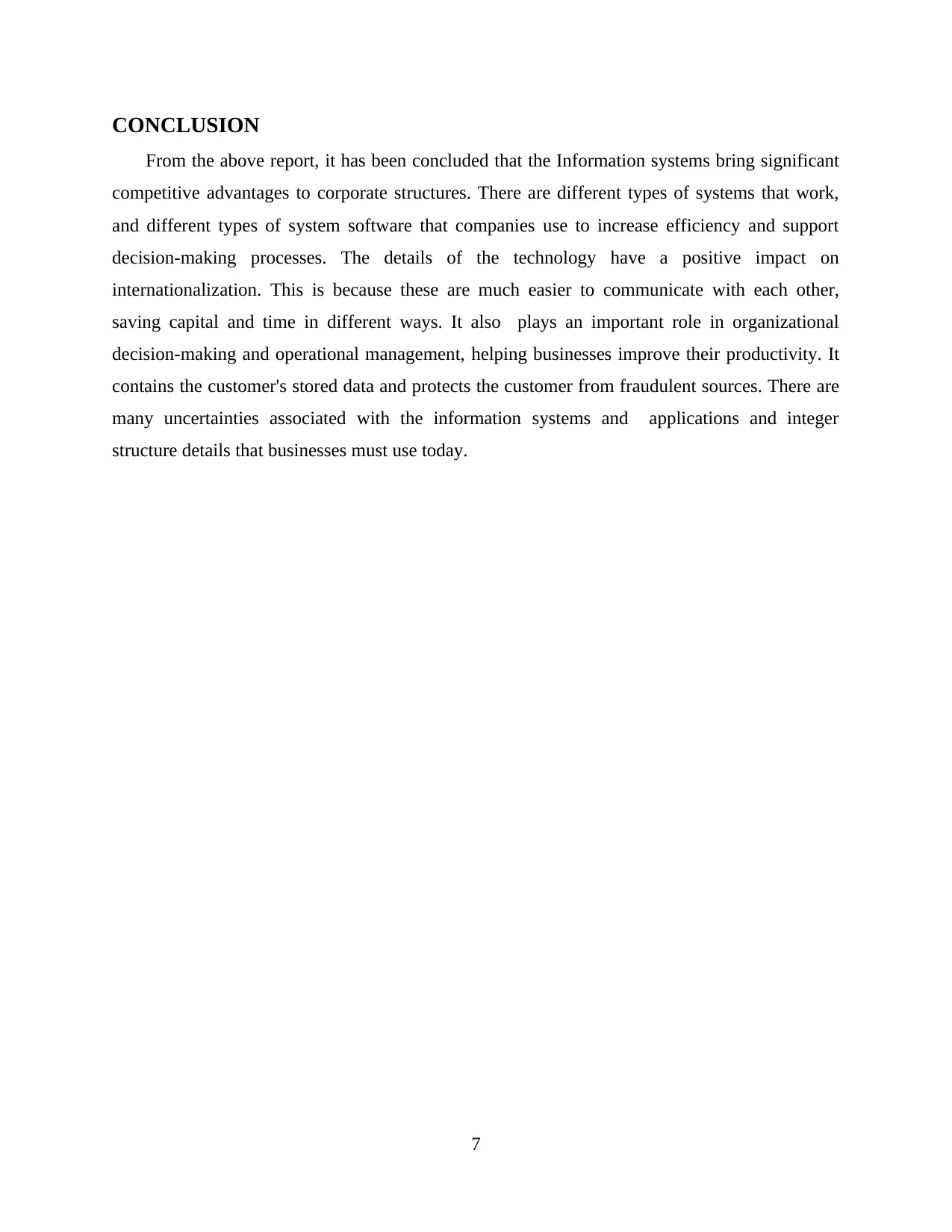
CONCLUSION
From the above report, it has been concluded that the Information systems bring significant
competitive advantages to corporate structures. There are different types of systems that work,
and different types of system software that companies use to increase efficiency and support
decision-making processes. The details of the technology have a positive impact on
internationalization. This is because these are much easier to communicate with each other,
saving capital and time in different ways. It also plays an important role in organizational
decision-making and operational management, helping businesses improve their productivity. It
contains the customer's stored data and protects the customer from fraudulent sources. There are
many uncertainties associated with the information systems and applications and integer
structure details that businesses must use today.
7
From the above report, it has been concluded that the Information systems bring significant
competitive advantages to corporate structures. There are different types of systems that work,
and different types of system software that companies use to increase efficiency and support
decision-making processes. The details of the technology have a positive impact on
internationalization. This is because these are much easier to communicate with each other,
saving capital and time in different ways. It also plays an important role in organizational
decision-making and operational management, helping businesses improve their productivity. It
contains the customer's stored data and protects the customer from fraudulent sources. There are
many uncertainties associated with the information systems and applications and integer
structure details that businesses must use today.
7
⊘ This is a preview!⊘
Do you want full access?
Subscribe today to unlock all pages.

Trusted by 1+ million students worldwide
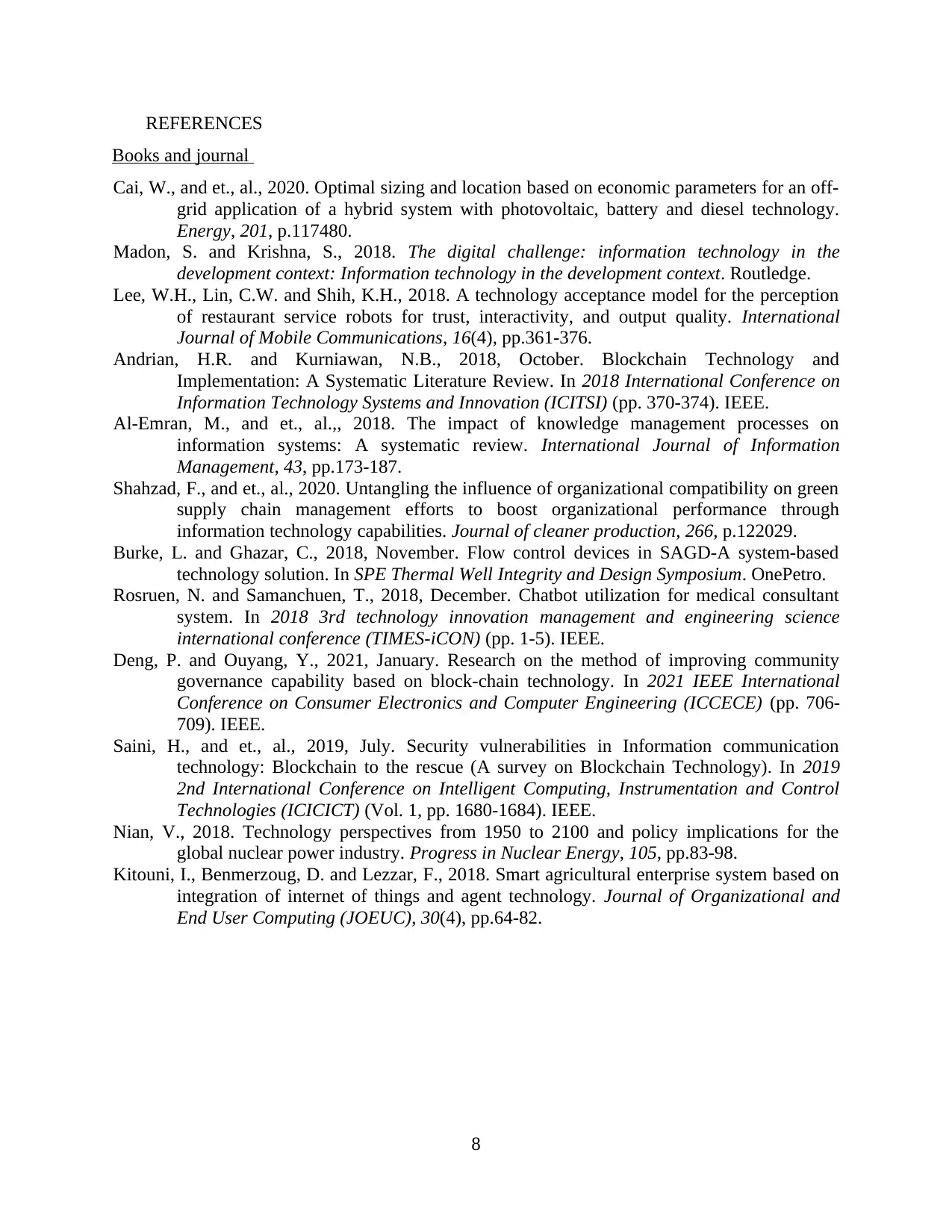
REFERENCES
Books and journal
Cai, W., and et., al., 2020. Optimal sizing and location based on economic parameters for an off-
grid application of a hybrid system with photovoltaic, battery and diesel technology.
Energy, 201, p.117480.
Madon, S. and Krishna, S., 2018. The digital challenge: information technology in the
development context: Information technology in the development context. Routledge.
Lee, W.H., Lin, C.W. and Shih, K.H., 2018. A technology acceptance model for the perception
of restaurant service robots for trust, interactivity, and output quality. International
Journal of Mobile Communications, 16(4), pp.361-376.
Andrian, H.R. and Kurniawan, N.B., 2018, October. Blockchain Technology and
Implementation: A Systematic Literature Review. In 2018 International Conference on
Information Technology Systems and Innovation (ICITSI) (pp. 370-374). IEEE.
Al-Emran, M., and et., al.,, 2018. The impact of knowledge management processes on
information systems: A systematic review. International Journal of Information
Management, 43, pp.173-187.
Shahzad, F., and et., al., 2020. Untangling the influence of organizational compatibility on green
supply chain management efforts to boost organizational performance through
information technology capabilities. Journal of cleaner production, 266, p.122029.
Burke, L. and Ghazar, C., 2018, November. Flow control devices in SAGD-A system-based
technology solution. In SPE Thermal Well Integrity and Design Symposium. OnePetro.
Rosruen, N. and Samanchuen, T., 2018, December. Chatbot utilization for medical consultant
system. In 2018 3rd technology innovation management and engineering science
international conference (TIMES-iCON) (pp. 1-5). IEEE.
Deng, P. and Ouyang, Y., 2021, January. Research on the method of improving community
governance capability based on block-chain technology. In 2021 IEEE International
Conference on Consumer Electronics and Computer Engineering (ICCECE) (pp. 706-
709). IEEE.
Saini, H., and et., al., 2019, July. Security vulnerabilities in Information communication
technology: Blockchain to the rescue (A survey on Blockchain Technology). In 2019
2nd International Conference on Intelligent Computing, Instrumentation and Control
Technologies (ICICICT) (Vol. 1, pp. 1680-1684). IEEE.
Nian, V., 2018. Technology perspectives from 1950 to 2100 and policy implications for the
global nuclear power industry. Progress in Nuclear Energy, 105, pp.83-98.
Kitouni, I., Benmerzoug, D. and Lezzar, F., 2018. Smart agricultural enterprise system based on
integration of internet of things and agent technology. Journal of Organizational and
End User Computing (JOEUC), 30(4), pp.64-82.
8
Books and journal
Cai, W., and et., al., 2020. Optimal sizing and location based on economic parameters for an off-
grid application of a hybrid system with photovoltaic, battery and diesel technology.
Energy, 201, p.117480.
Madon, S. and Krishna, S., 2018. The digital challenge: information technology in the
development context: Information technology in the development context. Routledge.
Lee, W.H., Lin, C.W. and Shih, K.H., 2018. A technology acceptance model for the perception
of restaurant service robots for trust, interactivity, and output quality. International
Journal of Mobile Communications, 16(4), pp.361-376.
Andrian, H.R. and Kurniawan, N.B., 2018, October. Blockchain Technology and
Implementation: A Systematic Literature Review. In 2018 International Conference on
Information Technology Systems and Innovation (ICITSI) (pp. 370-374). IEEE.
Al-Emran, M., and et., al.,, 2018. The impact of knowledge management processes on
information systems: A systematic review. International Journal of Information
Management, 43, pp.173-187.
Shahzad, F., and et., al., 2020. Untangling the influence of organizational compatibility on green
supply chain management efforts to boost organizational performance through
information technology capabilities. Journal of cleaner production, 266, p.122029.
Burke, L. and Ghazar, C., 2018, November. Flow control devices in SAGD-A system-based
technology solution. In SPE Thermal Well Integrity and Design Symposium. OnePetro.
Rosruen, N. and Samanchuen, T., 2018, December. Chatbot utilization for medical consultant
system. In 2018 3rd technology innovation management and engineering science
international conference (TIMES-iCON) (pp. 1-5). IEEE.
Deng, P. and Ouyang, Y., 2021, January. Research on the method of improving community
governance capability based on block-chain technology. In 2021 IEEE International
Conference on Consumer Electronics and Computer Engineering (ICCECE) (pp. 706-
709). IEEE.
Saini, H., and et., al., 2019, July. Security vulnerabilities in Information communication
technology: Blockchain to the rescue (A survey on Blockchain Technology). In 2019
2nd International Conference on Intelligent Computing, Instrumentation and Control
Technologies (ICICICT) (Vol. 1, pp. 1680-1684). IEEE.
Nian, V., 2018. Technology perspectives from 1950 to 2100 and policy implications for the
global nuclear power industry. Progress in Nuclear Energy, 105, pp.83-98.
Kitouni, I., Benmerzoug, D. and Lezzar, F., 2018. Smart agricultural enterprise system based on
integration of internet of things and agent technology. Journal of Organizational and
End User Computing (JOEUC), 30(4), pp.64-82.
8
1 out of 10
Related Documents
Your All-in-One AI-Powered Toolkit for Academic Success.
+13062052269
info@desklib.com
Available 24*7 on WhatsApp / Email
![[object Object]](/_next/static/media/star-bottom.7253800d.svg)
Unlock your academic potential
Copyright © 2020–2025 A2Z Services. All Rights Reserved. Developed and managed by ZUCOL.

